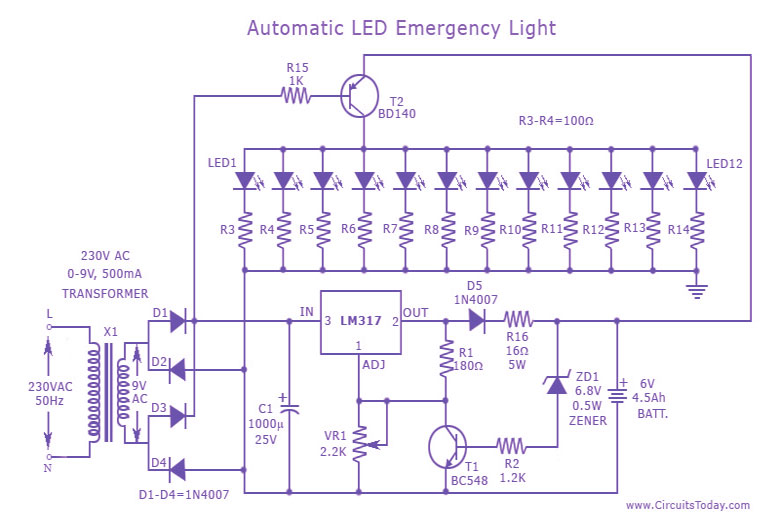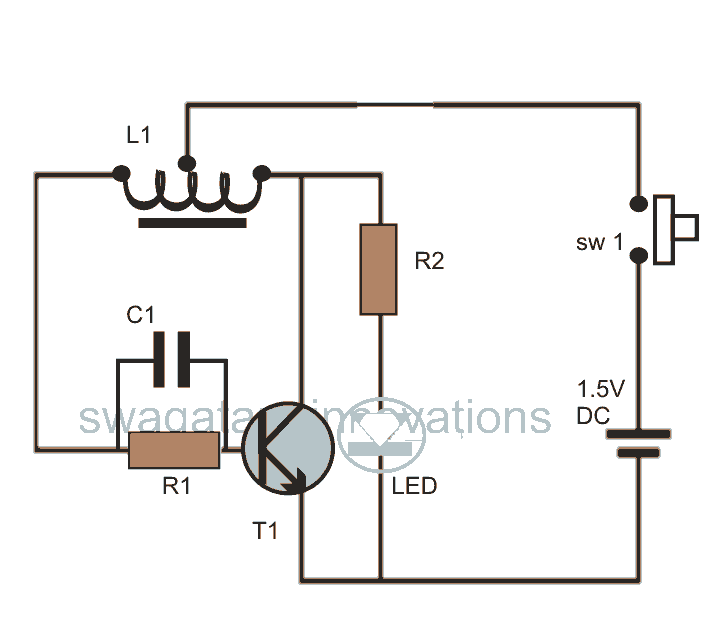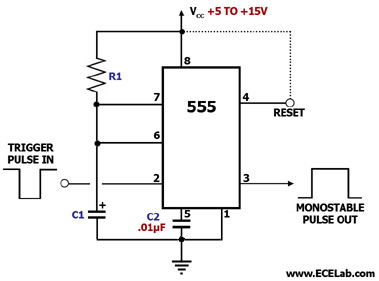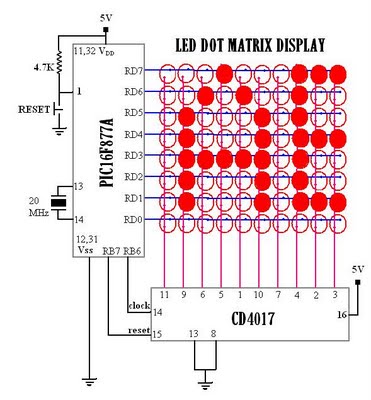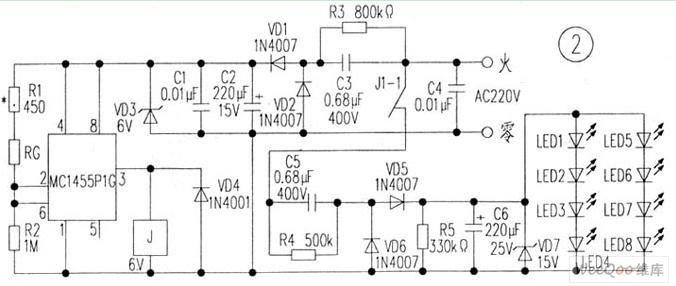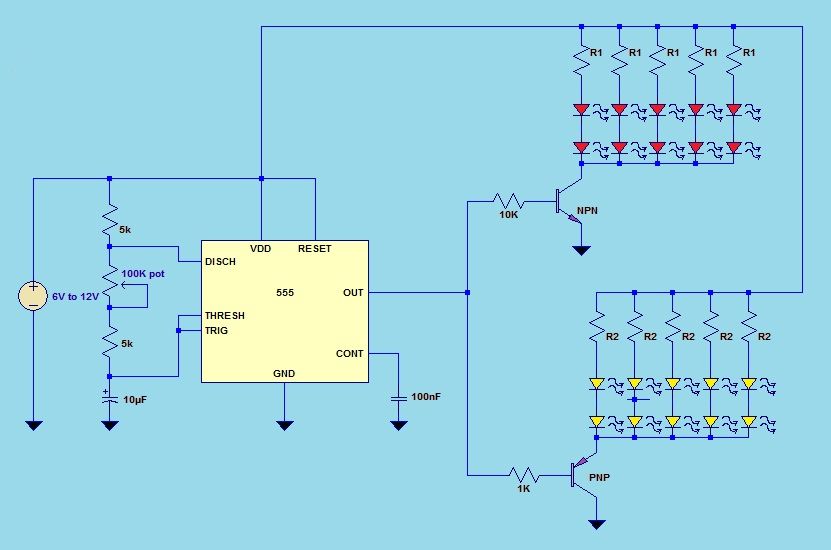
LED Voltmeter
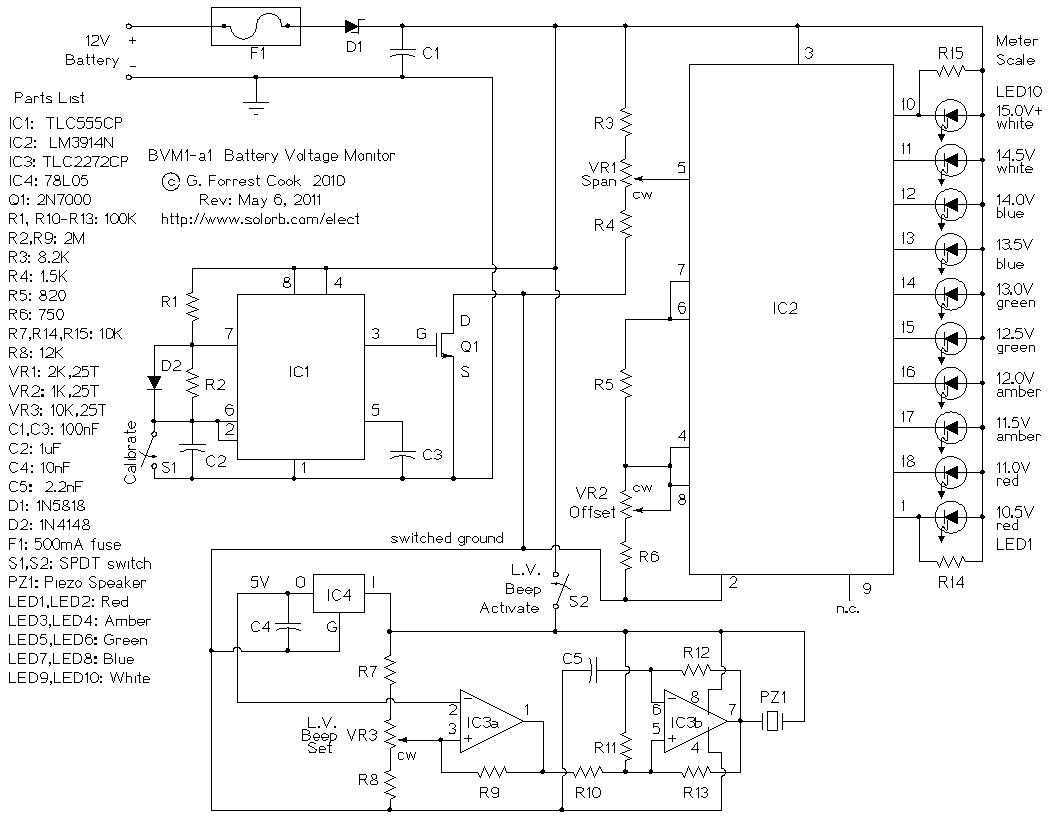
This is a low power voltmeter circuit that can be used with alternative energy systems that run on 12 and 24 volt batteries. The voltmeter is an expanded scale type that indicates small voltage steps over the 10 to 16 volt range for 12 volt batteries and over the 22 to 32 volt range for 24 volt batteries. Power consumption can be as low as 14mw when operated from 12V and 160mw when operated from 24V. It is possible to set the meter to read equal steps across a variety of upper and lower voltages. The meter saves power by operating in a low duty-cycle blinking mode where the LED indicators are only on and consuming power briefly during a repeating 2 seconds.
The low power voltmeter circuit is designed specifically for monitoring battery voltages in alternative energy systems, such as solar or wind power setups. The circuit utilizes an expanded scale voltmeter configuration, which allows for precise measurements of small voltage changes within the specified ranges. For 12V systems, the voltmeter can accurately display voltages from 10 to 16 volts, while for 24V systems, it covers the range of 22 to 32 volts.
The circuit's design emphasizes energy efficiency, with a power consumption of only 14 milliwatts at 12 volts and 160 milliwatts at 24 volts. This low power requirement is particularly advantageous in renewable energy applications, where battery longevity is crucial. The voltmeter employs a low duty-cycle blinking mode, wherein the LED indicators illuminate only momentarily, thus reducing overall power usage. This blinking occurs in a repeating cycle of 2 seconds, allowing for periodic voltage readings without significant energy expenditure.
The voltmeter can be calibrated to display equal voltage steps across different voltage ranges, making it versatile for various applications. This feature enables users to customize the display according to their specific monitoring needs, ensuring that critical voltage levels are easily readable. The circuit typically consists of a voltage divider network, an analog-to-digital converter (ADC), and a microcontroller or dedicated display driver to manage the LED indicators and provide the necessary visual feedback.
In summary, the low power voltmeter circuit is an efficient and adaptable solution for monitoring battery voltages in alternative energy systems, featuring precise measurement capabilities, low power consumption, and customizable display options.This is a low power voltmeter circuit that can be used with alternative energy systems that run on 12 and 24 volt batteries. The voltmeter is an expanded scale type that indicates small voltage steps over the 10 to 16 volt range for 12 volt batteries and over the 22 to 32 volt range for 24 volt batteries.
Power consumption can be as low as 14mw when operated from 12V and 160mw when operated from 24V. It is possible to set the meter to read equal steps across a variety of upper and lower voltages. The meter saves power by operating in a low duty-cycle blinking mode where the LED indicators are only on and consuming power briefly during a repeating 2 se 🔗 External reference
The low power voltmeter circuit is designed specifically for monitoring battery voltages in alternative energy systems, such as solar or wind power setups. The circuit utilizes an expanded scale voltmeter configuration, which allows for precise measurements of small voltage changes within the specified ranges. For 12V systems, the voltmeter can accurately display voltages from 10 to 16 volts, while for 24V systems, it covers the range of 22 to 32 volts.
The circuit's design emphasizes energy efficiency, with a power consumption of only 14 milliwatts at 12 volts and 160 milliwatts at 24 volts. This low power requirement is particularly advantageous in renewable energy applications, where battery longevity is crucial. The voltmeter employs a low duty-cycle blinking mode, wherein the LED indicators illuminate only momentarily, thus reducing overall power usage. This blinking occurs in a repeating cycle of 2 seconds, allowing for periodic voltage readings without significant energy expenditure.
The voltmeter can be calibrated to display equal voltage steps across different voltage ranges, making it versatile for various applications. This feature enables users to customize the display according to their specific monitoring needs, ensuring that critical voltage levels are easily readable. The circuit typically consists of a voltage divider network, an analog-to-digital converter (ADC), and a microcontroller or dedicated display driver to manage the LED indicators and provide the necessary visual feedback.
In summary, the low power voltmeter circuit is an efficient and adaptable solution for monitoring battery voltages in alternative energy systems, featuring precise measurement capabilities, low power consumption, and customizable display options.This is a low power voltmeter circuit that can be used with alternative energy systems that run on 12 and 24 volt batteries. The voltmeter is an expanded scale type that indicates small voltage steps over the 10 to 16 volt range for 12 volt batteries and over the 22 to 32 volt range for 24 volt batteries.
Power consumption can be as low as 14mw when operated from 12V and 160mw when operated from 24V. It is possible to set the meter to read equal steps across a variety of upper and lower voltages. The meter saves power by operating in a low duty-cycle blinking mode where the LED indicators are only on and consuming power briefly during a repeating 2 se 🔗 External reference
